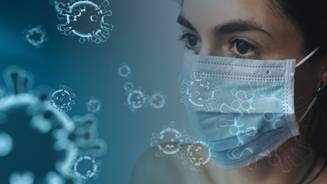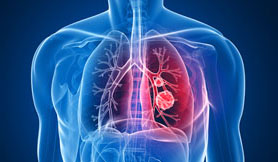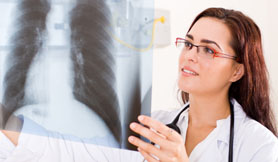Everything We Know About COVID-19, Precautions and Vaccines
 It’s been more than a year since the World Health Organization (WHO) declared COVID-19 a global pandemic. Though the emergence of several vaccines hold promise for helping us finally turning the corner in our battle against the virus, it still remains a threat — especially to those with underlying conditions such as chronic obstructive pulmonary disease (COPD).
It’s been more than a year since the World Health Organization (WHO) declared COVID-19 a global pandemic. Though the emergence of several vaccines hold promise for helping us finally turning the corner in our battle against the virus, it still remains a threat — especially to those with underlying conditions such as chronic obstructive pulmonary disease (COPD).
People with COPD are at risk
No one is immune to COVID-19. However, people with certain underlying conditions are a high risk of becoming severely ill if infected. One study published in the Archives of Academic Emergency Medicine
found that COPD was one of the prevalent underlying conditions among patients who had been hospitalized for COVID-19. Further analysis, including this article published in Respiratory Medicine, has also shown that people with COPD who catch COVID-19 are more likely to be admitted into the intensive care unit and placed on a ventilator. The same analysis also found that COPD sufferers are more likely to die from COVID-19.
The best way for people with COPD to avoid COVID-19 is to continue to practice the recommended safety measures: stay 6 feet away from other people, avoid large groups and gatherings, wash your hands frequently, use sanitizer and wear a snug-fitting mask with two layers. If you decide to quarantine, make sure you have an ample amount of your prescribed medications and oxygen, as well as a friend or family member who can run errands for you in the event you need something from the store.
It is also important you stay in contact with your physician and let them know if you are experiencing any symptoms of a COVID-19 infection as identified by the Centers for Disease Control and Prevention (CDC), such as a cough, fever and/or chills, fatigue and a new loss of taste or smell.
Masks are safe for COPD sufferers
The best way to prevent exposure to COVID-19 is to stay home. But if you choose to go out, it is important to wear at least one mask. There is some hesitancy to do so among some people with lung diseases such as COPD, who express concern that wearing a mask will restrict their breathing. That is not the case.
“They may feel slightly uncomfortable, but that’s not a sign that you’re getting less oxygen,” Frank Coletta, M.D., Director of Pulmonary Medicine and Chief of Critical Care at New York’s Mount Sinai South Nassau, told WebMD.
Michael Campos, M.D., a pulmonologist at the Miami VA Medical Center and the University of Miami Hospital and Clinics, conducted a study with 15 healthy people and 15 military veterans with severe COPD whose lungs functioned at less than 50%. He had each participant wear masks for 30 minutes and then walk six minutes while still wearing them. Blood tests were then conducted on each participant, which showed there were no changes to their oxygen or carbon dioxide levels.
Dr. Campos also found that some of the discomfort people feel while wearing a mask stems from anxiety, claustrophobia or a neurological response to warmer air touching the face, which can cause a perceived difficulty in breathing.
Christopher Ewing, M.D., a lung specialist in Alberta, Canada, told Discover Magazine that breathing is regulated by the nervous system — but can be influenced by our mind.
“When we’re feeling discomfort, even subconsciously, it can change the way we breathe,” he said. “Most of us aren’t used to wearing face masks, and the sensation of having a mask on your face might make someone anxious or uncomfortable.”
You can also check with your doctor if you are nervous about wearing a mask or if you are unsure of which one is best to use.
The COVID vaccines
It is important that people with COPD be vaccinated as soon as possible because they run a high risk of getting severely sick if infected. All three COVID-19 vaccines currently being administered in the U.S. under emergency use authorization (EAU) from the Food and Drug Administration (FDA) are safe for people with lung diseases.
According to an article published by Yale Medicine, despite their differences, all three vaccines may help us achieve herd immunity and a return to normalcy. Two of the vaccines, Pfizer-BioNTech and Moderna, use a relatively new technology called messenger RNA (mRNA) that involves delivering “a tiny piece of genetic code from the SARS CoV-2 virus to host cells in the body, essentially giving those cells instructions, or blueprints, for making copies of spike proteins (the spikes you see sticking out of the coronavirus in pictures online and on TV). The spikes do the work of penetrating and infecting host cells. These proteins stimulate an immune response, producing antibodies and developing memory cells that will recognize and respond if the body is infected with the actual virus.”
In rare instances—11 cases in 18 million vaccinations— mRNA vaccines have appeared to trigger anaphylaxis, a severe reaction that is treatable with epinephrine. As such, the CDC requires vaccination sites to monitor everyone for 15 minutes after their COVID-19 shot; 30 minutes for those with a history of severe allergies or who are on blood thinners.
Pfizer-BioNTechis the first COVID-19 vaccine to receive EAU and is recommended for anyone 16 and older. It consists of two shots, 21 days apart, and has a 95% efficacy in preventing COVID-19 in those without prior infection. It has been found to protect against the variant that was first detected in Great Britain (B.1.1.7) but may be less effective against the variant first detected in South Africa (B.1.351). Common side effects include chills, headache, pain, tiredness, and/or redness and swelling at the injection site, all of which typically disappear after a day or two of rest, hydration, and medications like acetaminophen.
Moderna is thesecond vaccine to receive EAU. Recommended for anyone 18 and older, it consists of two shots, 28 days apart, and is 94.1% effective at preventing symptomatic infection in people with no evidence of previous COVID-19 infection. Its efficacy rate drops to 86.4% for people ages 65 and older. Though still being studied, early research suggests that Moderna’s vaccine may provide protection against both known variants. Common side effects include chills, headache, pain, tiredness, and/or redness and swelling at the injection site and typically resolve within a day or two.
Unlike the Pfizer and Moderna vaccines, the Johnson & Johnsonvaccine is a viral vector vaccine that is recommended for anyone 18 and older and requires just one shot. It has a 72% overall efficacy and is 86% effective against severe disease, and an FDA analysis showed that it may reduce the spread of the virus by vaccinated people. The Johnson & Johnson vaccine protects against B.1.1.7 and has a lower overall efficacy against B.1.351. Side effects are noticeably milder than with the Pfizer and Moderna vaccines, the most common of which are fatigue, fever headache, injection site pain, or myalgia, which is pain in a muscle or group of muscles. All of which generally go away in day or two. The company also reports that no allergic reactions were suffered in clinical trials.
Like mRNA vaccines, viral vector vaccines instruct human cells to make the SARS CoV-2 spike protein but do so in a different manner. Scientists engineer a harmless adenovirus as a shell to carry genetic code—neither of which can make you sick—on the spike proteins to the cells. “Once the code is inside the cells, the cells produce a spike protein to train the body’s immune system, which creates antibodies and memory cells to protect against an actual SARS-CoV-2 infection,” according to the Yale Medicine article.
There are two additional vaccines—Oxford-AstraZeneca and Novavax—that are notyet available in the U.S.
Back to normal
When it comes to COVID-19, our body of knowledge is growing daily. Two things remain constant, however — the need to remain vigilant about wearing masks and social distancing until herd immunity is achieved, and the importance of speaking with your doctor about any concerns or uncertainty.
If we continue doing what we can to protect ourselves and others, a return to normalcy is within sight.
 An improved quality of life is the NEF mission.
An improved quality of life is the NEF mission.The NEF’s mission is to improve the quality of life of patients with emphysema and their caregivers by providing and supporting educational, advocacy and research... ARTICLE >
 Everything We Know About COVID-19, Precautions and Vaccines
Everything We Know About COVID-19, Precautions and VaccinesIt’s been more than a year since the World Health Organization (WHO) declared COVID-19 a global pandemic. Though the emergence of several vaccines hold promise for... ARTICLE >
 COPD and Emphysema afflict millions of adults and children today.
COPD and Emphysema afflict millions of adults and children today.An estimated 3.1 million Americans have been diagnosed with emphysema and 11.2 million U.S. adults have been estimated to have COPD. Emphysema and Chronic... ARTICLE >

